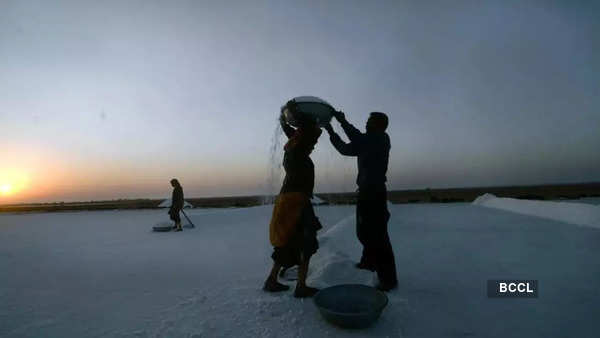Bones that don’t burn
As per reports, of the most striking effects of salt farming on the Agariyas is the calcification of their bones, especially in their legs. Due to the high concentration of salt in the groundwater, the Agariyas absorb large amounts of calcium and other minerals through their skin. This causes their bones to become abnormally hard and dense, making them resistant to fire. As a result, when the Agariyas die, their bones do not burn completely in the funeral pyre, unlike those of other people. Their relatives have to collect the unburnt bones and bury them separately in a small grave with salt, so that they can decompose naturally over time.
The result of such extensive salt farming is that the bones of the farmers get calcified, especially in the legs and the bones become excessiely hard and brittle. Source: Sugato Mukerjee/Al Jazeera
Another consequence of salt farming on the Agariyas is the deterioration of their eyesight. The bright light reflected from the white salt crystals and the dry air can damage their corneas and cause cataracts, glaucoma, and blindness. Many Agariyas suffer from eye infections and inflammation, and have to wear dark glasses or cloth to protect their eyes. Some of them even lose their vision completely, making them unable to work or perform daily activities.

The Agarias are responsible for the production of 75 percent of the country’s salt supply. Source: Sugato Mukerjee/Al Jazeera
Agariyas confront a range of health issues, including skin diseases, respiratory disorders, kidney stones, and hypertension. Prolonged exposure to salt and sunlight can result in skin complications such as cracking, bleeding, ulcers, and infections while inhaling dust and salt particles may trigger respiratory problems like asthma, bronchitis, and tuberculosis. Excessive salt consumption also heightens the risk of cardiovascular diseases and elevated blood pressure. Additionally, inadequate access to fresh water and sanitation contributes to dehydration, diarrhea, and susceptibility to typhoid among the Agariya community.
Despite these challenges, the Agariyas continue to work as salt farmers, as it is their only source of income and identity. They earn a meagre Rs 60 per ton of salt, while the traders and companies take most of the profits. They have little access to education, health care, social security, and legal rights. They are often exploited, discriminated against, and neglected by the government and society.
The Agariyas are a resilient and proud community, who have preserved their culture and traditions for centuries. They have a strong sense of belonging and solidarity, and celebrate festivals and ceremonies with joy and devotion. They have a deep connection with the land and the salt, which they consider as sacred and life-giving. They hope for a better future for themselves and their children, where they can live with dignity and respect.
UN emergency relief chief warns of an imminent famine in Gaza, describes it ‘around the corner’














































